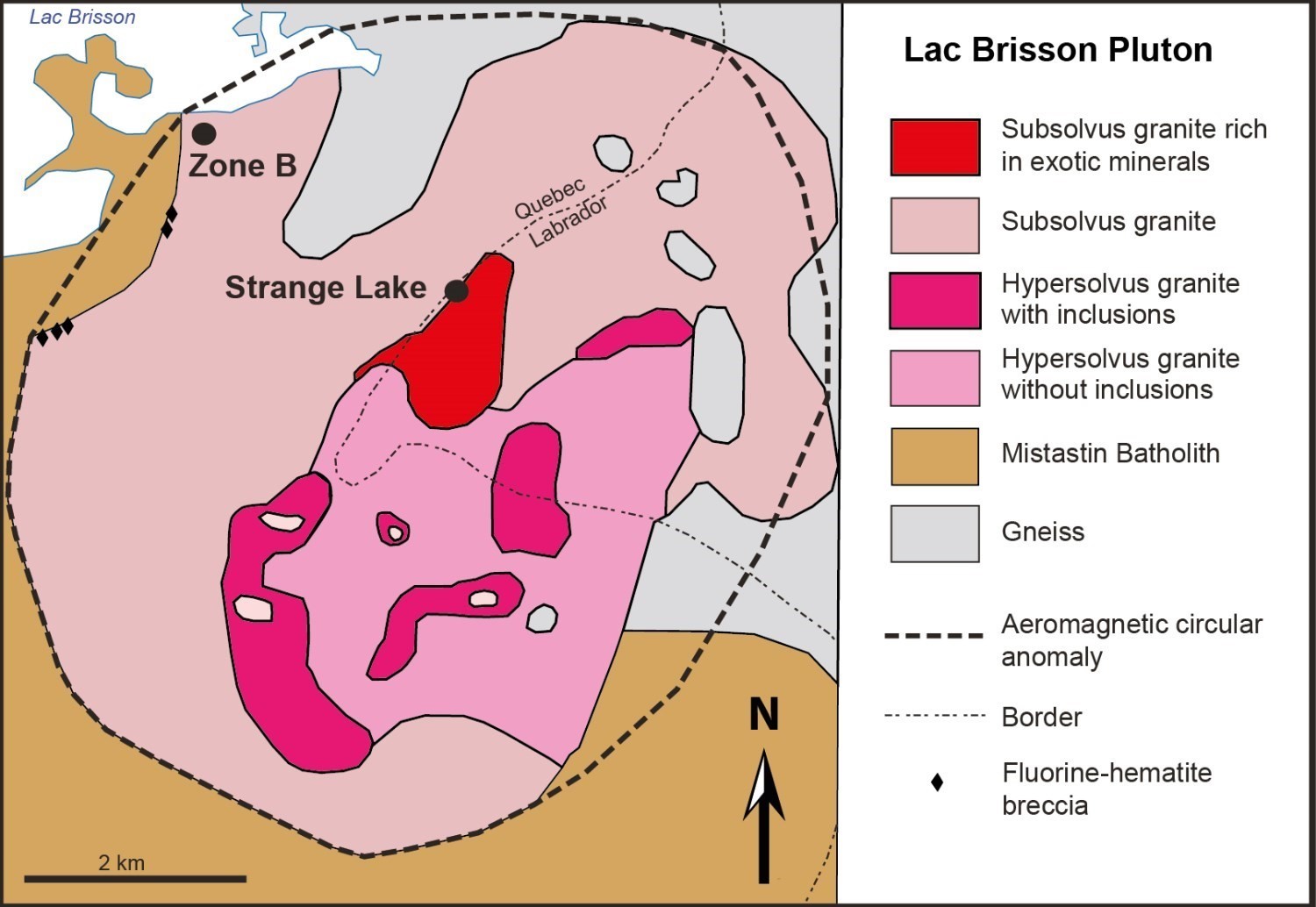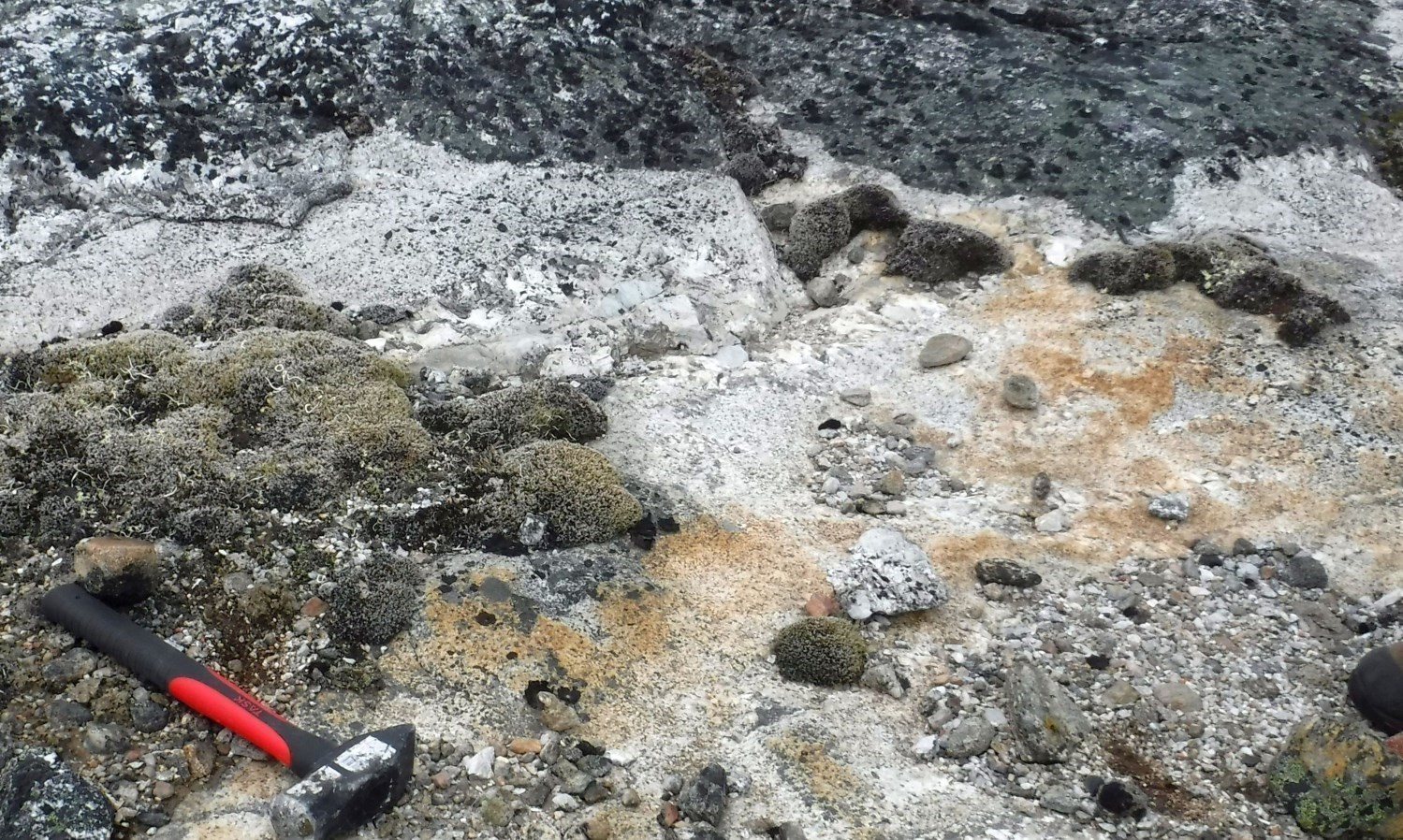
| Author: | Pillet, 1985 |
| Age: | Mesoproterozoic |
| Stratotype: | None |
| Type area: | Brisson Lake area (NTS sheet 24A08) |
| Geological province: | Churchill Province and Nain Province (Labrador) |
| Geological subdivision: | Mistinibi-Raude Lithotectonic Domain |
| Lithology: | Peralkaline granite |
| Category: | Lithodemic |
| Rank: | Lithodeme |
| Status: | Formal |
| Use: | Active |
None
Background
This unit, known for its rare earth element potential, was introduced under the term “Brisson Lake Peralkaline Granite” by Pillet (1985). It had previously been described by Taylor (1979) as an adamellitic rock (quartz monzonite), and by Bélanger (1984) as an amphibole hyperalkaline granite. This granite was renamed “Lac Brisson Pluton” in the regional compilation by the Ministère’s geologists in 2003. The Lac Brisson Pluton is equivalent to the Strange Lake peralkaline complex in Labrador, described by Zajac et al. (1984), Currie (1985) and Miller (1985).
The name of this unit comes from Brisson Lake, located near the Quebec-Labrador border (sheet 24A08). Note that the term “Strange Lake” refers to mineralized zones and mining property.
Description
The Lac Brisson Pluton contains several facies that are distinguished primarily by their mineralogy. These facies, defined by Nassif (1993), include hypersolvus granite and subsolvus granite. Within the same facies, the rock’s grain size can vary considerably. Fluorite-hematite breccia zones were reported by Pillet (1985) at the edge of the intrusion, specifically to the NW and SW.
Hypersolvus granite is a granite that crystallized above the solvus temperature and contains only one type of feldspar in the form of mesoperthite. Lac Brisson Pluton hypersolvus granite is generally poor in exotic minerals (<5%) such as elpidite, armstrongite, fluorite, gittinsite, zircon, gadolinite, sphene, pyrochlore and narsarsukite. The rock is greyish to greenish, massive and even grained, but includes fine to coarse-grained facies. Mesoperthite (30-70%) occurs as euhedral to subhedral crystals with edges reaching 12 mm and that contain albite exsolutions as films, veins and small, more or less globular zones. In addition to anhedral quartz (15-25%, up to 50% locally) interstitial with mesoperthite crystals, hypersolvus granite contains arfvedsonite amphibole (10-20%) and, in places, aegirine, zirconosilicates, fluorite and astrophyllite. Arfvedsonite occurs as isolated, interstitial and poikilitic crystals, occasionally zoned. In places, amphiboles form irregular clusters of intergrowth crystals.
Subsolvus granite is a granite that crystallized below the solvus temperature and contains both types of feldspar (plagioclase and K-feldspar). Unlike hypersolvus granite, subsolvus granite therefore includes two types of feldspar that crystallized separately below the orthose-albite solvus temperature. The colour of the rock varies from cream to brownish red. Submillimetric feldspar crystals consist of 20 to 35% microcline, and 10 to 15% albite predominantly as laths. In general, euhedral quartz (30-40%) is more abundant in this unit and would have crystallized earlier than in the case of hypersolvus granite (Nassif, 1993). Ferromagnesian minerals include 10% arfvedsonite as phenocrystals or small crystals in the matrix, and aegirine (0-10%). Locally, the proportion of arfvedsonite can be as much as 50% of the rock at the edge of hypersolvus granite. Amphibole crystals are not zoned. Subsolvus granite has a higher exotic mineral content. Pyrochlore, zirconosilicates, sphene, fluorite and opaque minerals are present in accessory amounts.
Although a pegmatitic phase is also recognized in hypersolvus granite, it is mainly associated with subsolvus granite. The most important mineralized zones are located in and around the pegmatitic facies. In places, pegmatite of subsolvus granite forms ~20 m thick subhorizontal veins locally zoned. This zoning is characterized by a margin rich in quartz, K-feldspar, arfvedsonite, zirconosilicates and titanosilicates, and a core of fluorite, quartz and minerals bearing rare earth elements.
Subsolvus granite is also characterized by strong hydrothermal alteration, particularly intense in and around the pegmatitic phase. In these alteration zones, arfvedsonite is altered to aegirine, while zirconosilicates and titanosilicates are replaced by quartz and gittinsite or sphene, respectively. Calcite, prehnite, kainosite and zircon are observed as interstitial accessory phases.
Transsolvus granite forms hectometric masses along the edge of hypersolvus granite. This granite shares some characteristics of hypersolvus and subsolvus granites. The rock is grey to greenish grey and contains submillimetric microcline and albite crystals forming a fine-grained matrix with quartz. The presence of small mesoperthitic phenocrystals (≤12 mm) is associated with a poorly developed porphyraceous texture. The composition of transsolvus granite is similar to that of hypersolvus granite (Pillet et al., 1992).
Thickness and Distribution
The Lac Brisson Pluton covers an area of 28 km2 in the eastern-central part of the Mistinibi-Raude Domain (Charette et al., 2019) straddling the Quebec-Labrador border. Hypersolvus granite forms the central and southeastern portion of the pluton. This lithology is commonly surrounded by porphyraceous transsolvus granite. Lenses of transsolvus granite are also observed in hypersolvus granite. Subsolvus granite is by volume the main unit of the intrusion.
Dating
A crystallization age around 1240 Ma was obtained in a fine-grained hypersolvus granite. Several cooling ages between 1275 Ma and 1120 Ma were obtained from K-Ar analyses on amphiboles and Rb-Sr analyses on total rocks (Wanless et al., 1973; Currie, 1985; Pillet et al., 1989).
| Unit | Sample Number | Isotopic System | Mineral | Crystallization Age (Ma) | (+) | (-) | Reference(s) |
| mPbri | BAB-88-016 | U-Pb | Zircon | 1240 | 2 | 2 | Miller et al., 1997 |
Stratigraphic Relationship(s)
The Lac Brisson Pluton cuts the Napeu Kainut Suite consisting of Mesoproterozoic granite and quartz monzonite. Enclaves of gneiss and surrounding Paleoproterozoic intrusive rocks are present in granite. The Lac Brisson Pluton also contains dark, microgranular, rounded and elongated enclaves that can account for up to 70% of outcrops. Pillet (1985) and Miller et al. (1997) propose that these enclaves represent transsolvus granite lenses. The Lac Brisson Pluton also appears to contain kilometric enclaves of Mistinibi Complex diatexite and Pelland Suite granoblastic gabbronorite.
According to the feldspar’s crystallization sequence, hypersolvus granite is interpreted as the oldest and least evolved unit of the Lac Brisson Pluton (Nassif, 1993).
Paleontology
Does not apply.
References
| Author(s) | Title | Year of Publication | Hyperlink (EXAMINE or Other) |
|---|---|---|---|
| BÉLANGER, M. | Région du lac Brisson, Territoire du Nouveau-Québec. Ministère de l’Énergie et des Ressources, Québec; DP 84-20, 2 cartes annotées. | 1984 | DP 84-20 |
| CURRIE, K.L. | An unusual peralkaline granite near Lac Brisson, Quebec-Labrador. Geological Survey of Canada; Paper 85-1A, pages 73-80. | 1985 | Source |
| CHARETTE, B. – LAFRANCE, I. – GODET, A. – VANIER, M.-A. | Domaine de Mistinibi-Raude, sud-est de la Province de Churchill, Nunavik, Québec, Canada : synthèse de la géologie. Ministère de l’Énergie et des Ressources naturelles, Québec. BG 2019-07. | 2019 | BG 2019-07 |
| MILLER, R.R. | Geology of the Strange Lake alkalic complex and the associated Zr-Y-Nb-Be-REE mineralization. In Granite-related mineral deposit; Geology, Petrogenesis and Tectonic setting (R.P. Taylor and D.F. Strong, editors). Canadian Institute of Mining and Metallurgy conference on granite-related mineral deposits, pages 193-196. | 1985 | Source |
| MILLER, R.R. – HEAMAN, L.M. – BIRKETT, T.C. | U-Pb zircon age of the Strange Lake peralkaline complex: implications for Mesoproterozoic peralkaline magmatism in north-central Labrador. Precambrian Research; volume 81, pages 67-82. | 1997 | Source |
| NASSIF, G.J. | The Strange Lake peralkaline Complex, Québec-Labrador: the hypersolvus-subsolvus granite transition and feldspar mineralogy. McGill University; master’s thesis, 104 pages. | 1993 | – |
| PILLET, D. | Le granite peralcalin du lac Brisson, Territoire du Nouveau-Québec : résultats préliminaires. Ministère de l’Énergie et des Ressources, Québec; MB 85-37, 52 pages, 1 plan. | 1985 | MB 85-37 |
| PILLET, D. – BONHOMME, M.G. – DUTHOU, J.L. – CHENEVOY, M. | Chronologie Rb-Sr et K-Ar du granite peralcalin du lac Brisson, Labrador central, Nouveau-Québec. Journal canadien des Sciences de la Terre; volume 26, pages 328-332. | 1989 | Source |
| PILLET, D. – CHENEVOY, M. – BÉLANGER, M. | Pétrologie du granite peralcalin du lac Brisson, Labrador central, Nouveau-Québec : 1. Mise en place et évolution chimique. Journal canadien des Sciences de la Terre; volume 29, pages 353-372. | 1992 | Source |
| TAYLOR, F.C. | Reconnaissance geology of a part of the Precambrian Shield, Northeastern Quebec, Northern Labrador and Northwest Territories. Geological Survey of Canada; Memoir 393, 99 pages. | 1979 | Source |
| WANLESS, R.K. – STEVENS, R.D. – LACHANCE, G.R. – DELABIO, R.N. | Age determinations and geological studies, K-Ar isotopic ages, report 11. Geological Survey of Canada; Paper 73-2, 139 pages. | 1973 | Source |
| ZAJAC, I.S. – MILLER, R. R. – BIRKETT, T.C. – NANTEL, S. | Le gîte de Zr, Y, Nb et Be du complexe alcalin de Strange Lake, Québec-Labrador. Ministère de l’Énergie et des Ressources, Québec; DV 84-18, pages 127-142. | 1984 | DV 84-18 |



